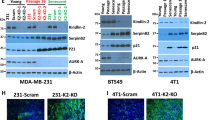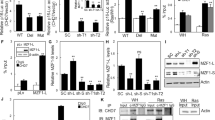Abstract
The induction of senescence-like growth arrest has emerged as a putative contributor to the anticancer effects of chemotherapeutic agents. Clinical trials are underway to evaluate the efficacy of inhibitors for class I and II histone deacetylases to treat malignancies. However, a potential antiproliferative effect of inhibitor for Sirt1, which is an NAD+-dependent deacetylase and belongs to class III histone deacetylases, has not yet been explored. Here, we show that Sirt1 inhibitor, Sirtinol, induced senescence-like growth arrest characterized by induction of senescence-associated β-galactosidase activity and increased expression of plasminogen activator inhibitor 1 in human breast cancer MCF-7 cells and lung cancer H1299 cells. Sirtinol-induced senescence-like growth arrest was accompanied by impaired activation of mitogen-activated protein kinase (MAPK) pathways, namely, extracellular-regulated protein kinase, c-jun N-terminal kinase and p38 MAPK, in response to epidermal growth factor (EGF) and insulin-like growth factor-I (IGF-I). Active Ras was reduced in Sirtinol-treated senescent cells compared with untreated cells. However, tyrosine phosphorylation of the receptors for EGF and IGF-I and Akt/PKB activation were unaltered by Sirtinol treatment. These results suggest that inhibitors for Sirt1 may have anticancer potential, and that impaired activation of Ras–MAPK pathway might take part in a senescence-like growth arrest program induced by Sirtinol.
This is a preview of subscription content, access via your institution
Access options
Subscribe to this journal
Receive 50 print issues and online access
$259.00 per year
only $5.18 per issue
Buy this article
- Purchase on Springer Link
- Instant access to full article PDF
Prices may be subject to local taxes which are calculated during checkout












Similar content being viewed by others
References
Alexander K, Hinds PW . (2001). Mol Cell Biol 21: 3616–3631.
Aviv H, Khan MY, Skurnick J, Okuda K, Kimura M, Gardner J et al. (2001). Atherosclerosis 159: 281–287.
Beausejour CM, Krtolica A, Galimi F, Narita M, Lowe SW, Yaswen P et al. (2003). EMBO J 22: 4212–4222.
Bedalov A, Gatbonton T, Irvine WP, Gottschling DE, Simon JA . (2001). Proc Natl Acad Sci USA 98: 15113–15118.
Ben-Porath I, Weinberg RA . (2004). J Clin Invest 113: 8–13.
Blander G, Guarente L . (2004). Annu Rev Biochem 73: 417–435.
Brunet A, Sweeney LB, Sturgill JF, Chua KF, Greer PL, Lin Y et al. (2004). Science 303: 2011–2015.
Carrano AC, Eytan E, Hershko A, Pagano M . (1999). Nat Cell Biol 1: 193–199.
Chang BD, Broude EV, Dokmanovic M, Zhu H, Ruth A, Xuan Y et al. (1999a). Cancer Res 59: 3761–3767.
Chang BD, Xuan Y, Broude EV, Zhu H, Schott B, Fang J et al. (1999b). Oncogene 18: 4808–4818.
Cheng HL, Mostoslavsky R, Saito S, Manis JP, Gu Y, Patel P et al. (2003). Proc Natl Acad Sci USA 100: 10794–10799.
Christov KT, Shilkaitis AL, Kim ES, Steele VE, Lubet RA . (2003). Eur J Cancer 39: 230–239.
Cohen HY, Lavu S, Bitterman KJ, Hekking B, Imahiyerobo TA, Miller C et al. (2004). Mol Cell 13: 627–638.
Collado M, Medema RH, Garcia-Cao I, Dubuisson ML, Barradas M, Glassford J et al. (2000). J Biol Chem 275: 21960–21968.
Daitoku H, Hatta M, Matsuzaki H, Aratani S, Ohshima T, Miyagishi M et al. (2004). Proc Natl Acad Sci USA 101: 10042–10047.
Dimri GP, Lee X, Basile G, Acosta M, Scott G, Roskelley C et al. (1995). Proc Natl Acad Sci USA 92: 9363–9367.
Elegbede JA, Hayes K, Schell K, Oberley TD, Verma AK . (2002). Life Sci 71: 421–436.
Elmore LW, Rehder CW, Di X, McChesney PA, Jackson-Cook CK, Gewirtz DA et al. (2002). J Biol Chem 277: 35509–35515.
Fujita N, Sato S, Katayama K, Tsuruo T . (2002). J Biol Chem 277: 28706–28713.
Gnudi L, Frevert EU, Houseknecht KL, Erhardt P, Kahn BB . (1997). Mol Endocrinol 11: 67–76.
Goldstein S, Moerman EJ, Fujii S, Sobel BE . (1994). J Cell Physiol 161: 571–579.
Grozinger CM, Chao ED, Blackwell HE, Moazed D, Schreiber SL . (2001). J Biol Chem 276: 38837–38843.
Han Z, Wei W, Dunaway S, Darnowski JW, Calabresi P, Sedivy J et al. (2002). J Biol Chem 277: 17154–17160.
Imai S, Armstrong CM, Kaeberlein M, Guarente L . (2000). Nature 403: 795–800.
Jirawatnotai S, Moons DS, Stocco CO, Franks R, Hales DB, Gibori G et al. (2003). J Biol Chem 278: 17021–17027.
Kahlem P, Dorken B, Schmitt CA . (2004). J Clin Invest 113: 169–174.
Kelly WK, Richon VM, O’Connor O, Curley T, MacGregor-Curtelli B, Tong W et al. (2003). Clin Cancer Res 9: 3578–3588.
Kim JH, Lee GE, Kim SW, Chung IK . (2003). Biochem J 373: 523–529.
Klesse LJ, Meyers KA, Marshall CJ, Parada LF . (1999). Oncogene 18: 2055–2068.
Landry J, Sutton A, Tafrov ST, Heller RC, Stebbins J, Pillus L et al. (2000). Proc Natl Acad Sci USA 97: 5807–5811.
Lange-Carter CA, Johnson GL . (1994). Science 265: 1458–1461.
Langley E, Pearson M, Faretta M, Bauer UM, Frye RA, Minucci S et al. (2002). EMBO J 21: 2383–2396.
Luo J, Nikolaev AY, Imai S, Chen D, Su F, Shiloh A et al. (2001). Cell 107: 137–148.
Mallette FA, Goumard S, Gaumont-Leclerc MF, Moiseeva O, Ferbeyre G . (2004). Oncogene 23: 91–99.
Mathon NF, Lloyd AC . (2001). Nat Rev Cancer 1: 203–213.
McLaughlin F, La Thangue NB . (2004). Curr Drug Targets Inflamm Allergy 3: 213–219.
Motta MC, Divecha N, Lemieux M, Kamel C, Chen D, Gu W et al. (2004). Cell 116: 551–563.
Munro J, Barr NI, Ireland H, Morrison V, Parkinson EK . (2004). Exp Cell Res 295: 525–538.
Pelicci PG . (2004). J Clin Invest 113: 4–7.
Picard F, Kurtev M, Chung N, Topark-Ngarm A, Senawong T, Machado De Oliveira R et al. (2004). Nature 429: 771–776.
Piekarz R, Bates S . (2004). Curr Pharm Des 10: 2289–2298.
Piekarz RL, Robey R, Sandor V, Bakke S, Wilson WH, Dahmoush L et al. (2001). Blood 98: 2865–2868.
Roninson IB . (2002). Drug Resist Updat 5: 204–208.
Roninson IB . (2003). Cancer Res 63: 2705–2715.
Rosato RR, Grant S . (2004). Expert Opin Investig Drugs 13: 21–38.
Sakaue H, Hara K, Noguchi T, Matozaki T, Kotani K, Ogawa W et al. (1995). J Biol Chem 270: 11304–11309.
Sandor V, Bakke S, Robey RW, Kang MH, Blagosklonny MV, Bender J et al. (2002). Clin Cancer Res 8: 718–728.
Schmitt CA, Fridman JS, Yang M, Lee S, Baranov E, Hoffman RM et al. (2002). Cell 109: 335–346.
Serrano M, Lin AW, McCurrach ME, Beach D, Lowe SW . (1997). Cell 88: 593–602.
Seshadri T, Campisi J . (1990). Science 247: 205–209.
Sharpless NE, DePinho RA . (2004). J Clin Invest 113: 160–168.
Shay JW, Roninson IB . (2004). Oncogene 23: 2919–2933.
Sugita H, Fujimoto M, Yasukawa T, Shimizu N, Sugita M, Yasuhara S et al. (2005). J Biol Chem 280: 14203–14211.
Takahashi T, Nowakowski RS, Caviness Jr VS . (1992). J Neurocytol 21: 185–197.
te Poele RH, Okorokov AL, Jardine L, Cummings J, Joel SP . (2002). Cancer Res 62: 1876–1883.
Torres C, Francis MK, Lorenzini A, Tresini M, Cristofalo VJ . (2003). Exp Cell Res 290: 195–206.
Tresini M, Lorenzini A, Frisoni L, Allen RG, Cristofalo VJ . (2001). Exp Cell Res 269: 287–300.
van der Horst A, Tertoolen LG, de Vries-Smits LM, Frye RA, Medema RH, Burgering BM . (2004). J Biol Chem 279: 28873–28879.
Vanhaecke T, Papeleu P, Elaut G, Rogiers V . (2004). Curr Med Chem 11: 1629–1643.
Vaziri H, Dessain SK, Ng Eaton E, Imai SI, Frye RA, Pandita TK et al. (2001). Cell 107: 149–159.
Vigushin DM, Coombes RC . (2004). Curr Cancer Drug Targets 4: 205–218.
Wagner M, Hampel B, Bernhard D, Hala M, Zwerschke W, Jansen-Durr P . (2001). Exp Gerontol 36: 1327–1347.
Wainwright LJ, Lasorella A, Iavarone A . (2001). Proc Natl Acad Sci USA 98: 9396–9400.
Wang X, Tsao SW, Wong YC, Cheung AL . (2003). Curr Cancer Drug Targets 3: 153–159.
Wright WE, Shay JW . (2001). Curr Opin Genet Dev 11: 98–103.
Yasukawa T, Tokunaga E, Ota H, Sugita H, Martyn JA, Kaneki M . (2005). J Biol Chem 280: 7511–7518.
Zhu WY, Jones CS, Kiss A, Matsukuma K, Amin S, De Luca LM . (1997). Exp Cell Res 234: 293–299.
Acknowledgements
We thank Drs J Avruch and N Fujita for helpful discussion and the p27 cDNA probe, respectively. This work was supported by National Institute of Health (NIH) Grant R01DK058127 (MK).
Author information
Authors and Affiliations
Corresponding author
Additional information
Supplementary Information accompanies the paper on Oncogene website (http://www.nature.com/onc).
Rights and permissions
About this article
Cite this article
Ota, H., Tokunaga, E., Chang, K. et al. Sirt1 inhibitor, Sirtinol, induces senescence-like growth arrest with attenuated Ras–MAPK signaling in human cancer cells. Oncogene 25, 176–185 (2006). https://doi.org/10.1038/sj.onc.1209049
Received:
Accepted:
Published:
Issue Date:
DOI: https://doi.org/10.1038/sj.onc.1209049
Keywords
This article is cited by
-
Inflammatory Modulation of miR-155 Inhibits Doxorubicin-Induced Testicular Dysfunction via SIRT1/FOXO1 Pathway: Insight into the Role of Acacetin and Bacillus cereus Protease
Applied Biochemistry and Biotechnology (2022)
-
The metabolic roots of senescence: mechanisms and opportunities for intervention
Nature Metabolism (2021)
-
Senescence under appraisal: hopes and challenges revisited
Cellular and Molecular Life Sciences (2021)
-
Inhibition of SIRT1/2 upregulates HSPA5 acetylation and induces pro-survival autophagy via ATF4-DDIT4-mTORC1 axis in human lung cancer cells
Apoptosis (2019)
-
Checkpoint suppressor 1 suppresses transcriptional activity of ERα and breast cancer cell proliferation via deacetylase SIRT1
Cell Death & Disease (2018)



